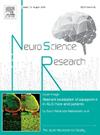Young fecal microbiota transplantation improves working memory in aged recipient rats by increasing interleukin-4 and interleukin-17 levels
IF 2.3
4区 医学
Q3 NEUROSCIENCES
引用次数: 0
Abstract
While transplanting the fecal microbiota from young to aged rodents has been extensively studied (that is, young FMT [yFMT]), its mechanism of alleviating working memory decline has not been fully elucidated. In this report, we aimed to investigate the effect of yFMT on the working memory of aged recipient rats performing delayed match-to-position (DMTP) tasks and the associated cellular and molecular mechanisms. The results revealed that yFMT mitigated the decline in DMTP task performance of aged recipients. This improvement was associated with a reshaped gut microbiota and increased levels of brain-derived neurotrophic factor, N-methyl-D-aspartate receptor subunit 1, and synaptophysin, enhancing synaptic formation and transmission. The remodeling of the gut microbiome influenced peripheral circulation and the hippocampus and medial prefrontal cortex by regulating the Th17/Treg ratio and microglial polarization. Ultimately, interleukin-4 and interleukin-17 emerged as potential key molecules driving the beneficial effects of FMT. These observations provide new insights into the gut![]() brain axis, emphasizing the connection between the gut and brain through the circulation system, and suggest an immunological mechanism that may help reverse age-related declines in the gut microbiota.
brain axis, emphasizing the connection between the gut and brain through the circulation system, and suggest an immunological mechanism that may help reverse age-related declines in the gut microbiota.
年轻粪便微生物群移植通过增加白细胞介素-4和白细胞介素-17水平改善老年受体大鼠的工作记忆。
虽然将幼龄啮齿类动物的粪便微生物群移植到老年啮齿类动物(即幼龄FMT [yFMT])已经得到了广泛的研究,但其缓解工作记忆衰退的机制尚未完全阐明。在本报告中,我们旨在研究yFMT对老年受体大鼠执行延迟匹配位置(DMTP)任务的工作记忆的影响及其相关的细胞和分子机制。结果表明,yFMT减轻了老年接受者DMTP任务性能的下降。这种改善与肠道微生物群的重塑和脑源性神经营养因子、n-甲基-d -天冬氨酸受体亚基1和突触素水平的增加有关,从而增强了突触的形成和传递。肠道微生物群的重塑通过调节Th17/Treg比值和小胶质细胞极化影响外周循环、海马和内侧前额叶皮质。最终,白细胞介素-4和白细胞介素-17成为驱动FMT有益作用的潜在关键分子。这些观察结果为肠脑轴提供了新的见解,强调了肠道和大脑之间通过循环系统的联系,并提出了一种免疫机制,可能有助于逆转肠道微生物群与年龄相关的下降。
本文章由计算机程序翻译,如有差异,请以英文原文为准。
求助全文
约1分钟内获得全文
求助全文
来源期刊

Neuroscience Research
医学-神经科学
CiteScore
5.60
自引率
3.40%
发文量
136
审稿时长
28 days
期刊介绍:
The international journal publishing original full-length research articles, short communications, technical notes, and reviews on all aspects of neuroscience
Neuroscience Research is an international journal for high quality articles in all branches of neuroscience, from the molecular to the behavioral levels. The journal is published in collaboration with the Japan Neuroscience Society and is open to all contributors in the world.
 求助内容:
求助内容: 应助结果提醒方式:
应助结果提醒方式:


